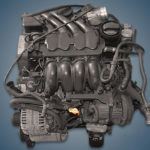The 1.6-liter 8-valve Volkswagen AKL engine was produced from 1996 to 2010 and was installed on many mass models of the company, including cars from Skoda and Seat. This motor is known in many countries, primarily for the very popular Skoda Octavia Tour.
The EA113-1.6 series includes: AEH, AHL, AKL, ALZ, ANA, APF, ARM, AVU, BFQ, BGU, BSE, BSF.
Specifications
| Production years | 1996-2010 |
| Displacement, cc | 1595 |
| Fuel system | injector |
| Power output, hp | 101 |
| Torque output, Nm | 145 |
| Cylinder block | aluminum R4 |
| Block head | aluminum 8v |
| Cylinder bore, mm | 81 |
| Piston stroke, mm | 77.4 |
| Compression ratio | 10.3 |
| Features | SOHC |
| Hydraulic lifters | yes |
| Timing drive | belt |
| Phase regulator | no |
| Turbocharging | no |
| Recommended engine oil | 5W-30 |
| Engine oil capacity, liter | 4.5 |
| Fuel type | petrol |
| Euro standards | EURO 3/4 |
| Fuel consumption, L/100 km (for VW Golf 4 1998) — city — highway — combined |
10.5 5.6 7.6 |
| Engine lifespan, km | ~350 000 |
The engine was installed on:
- Audi A3 1 (8L) in 1996 – 2000;
- Seat Cordoba 1 (6K) in 1999 – 2002;
- Seat Ibiza 2 (6K) in 1999 – 2002;
- Seat Leon 1 (1M) in 1999 – 2000;
- Seat Toledo 2 (1M) in 1998 – 2000;
- Skoda Octavia 1 (1U) in 1997 – 2010;
- Volkswagen Bora 1 (1J) in 1998 – 2000;
- Volkswagen Golf 4 (1J) in 1997 – 2000.
Disadvantages of the VW AKL engine
- The most famous motor problems are floating engine speeds and strong vibrations.
- To get rid of these ailments, cleaning nozzles or a throttle often helps.
- In second place are all breakdowns associated with the crankcase exhaust system.
- Owners also often complain about the loss of tightness of the intake manifold.
- By 200,000 km, rings or caps usually wear out and an oil burn begins.






